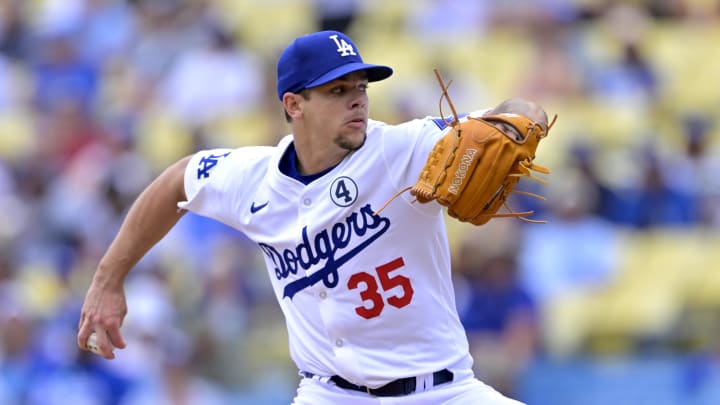National League Rookie Roundup: How First-Year Players Have Impacted NL’s Winning Teams

Welcome to the Rookie Roundup, a weekly look-in on baseball’s best and most interesting first-year players. Last week, we checked in on standout rookies for every last-place team in the American League. This week, we’ll look at the four National League squads who have records above .500 and see which rookies have made key contributions to their team’s winning ways.
Compared to the three other major North American sports, baseball has always created for its teams the most difficult path to the postseason. Twelve out of 30 clubs (40%) make the playoffs after the league expanded the field from 10 back in 2022. In the NFL, 14 of 32 teams (44%) make the field; the NHL lets half of its 32 teams into the postseason; and the NBA allows 16 of 30 squads to compete.
MLB standings don’t mean that much in mid-June, but a look at the playoff picture in the National League reveals a pretty bleak outlook already.
Entering play on Monday, only four of the 15 NL clubs have records above .500. There’s a four-way tie for the third wild-card spot, and even the perennially dysfunctional New York Mets are only three games back of joining the fray. While there’s still time for teams to find their footing, there’s no way to put this mildly: This is a complete mess.
Rather than leaning into snark and poking fun at the widespread mediocrity, let’s instead fix our gaze upon the league’s four winning teams and highlight the contributions from each side’s rookies that have made the biggest impacts so far. Perhaps the bottom two-thirds of the NL can similarly lean on youth to crawl above .500 sometime soon.
Philadelphia Phillies
Key contributor: RP Orion Kerkering
To date, the Phillies have played only two rookies all season: Kerkering and 29-year-old outfielder Weston Wilson, who’s managed only three plate appearances. Therefore, the former earns this distinction by default, though the righthander has been excellent in his first extended look at big-league hitters.
Kerkering’s fastball, which averages 97.8 mph, has overwhelmed opposing hitters, who have managed a batting average of .095 against it. The 23-year-old has allowed just two extra-base hits (both doubles) in 87 batters faced, with 24 strikeouts and just four walks. Kerkering has become a key member in what’s been a dominant Philadelphia bullpen, teaming with Jeff Hoffman and Matt Strahm to get the ball to closer José Alvarado. Phillies fans have experienced their fair share of bullpen meltdowns over the years, but perhaps Kerkering & Co. can maintain their form deep into October.
Los Angeles Dodgers
Key contributors: SP Yoshinobu Yamamoto, SP Gavin Stone, OF Andy Pages
Yamamoto and Pages have been highlighted in this space before, but Stone has inexcusably flown under the radar despite putting together a thoroughly impressive rookie campaign to date. A fifth-round pick in 2020, Stone made a brief debut last year and was rushed into the Dodgers’ rotation this season as the team managed injuries to other arms. The 25-year-old has been a much-needed steadying presence: He leads the team with seven wins and has a 2.93 ERA in 12 outings. Over his last 10 starts, he’s given up two runs or fewer in nine of them.
Yamamoto has been as dominant as advertised and has started going deeper into games as he develops into a true staff ace: He’s pitched into the seventh inning three times in his last six starts after failing to do so in any of his first seven outings. Pages has cooled off a bit since his scorching start but overall has provided stability as Los Angeles has dealt with injuries or ineffectiveness from the outfielder group of Chris Taylor, James Outman and Jason Heyward.
Milwaukee Brewers
Key contributors: 3B Joey Ortiz, RP Bryan Hudson, SP Tobias Myers
As the Brewers’ most-hyped first-year player—outfielder Jackson Chourio—struggles through his first two months in the majors, Ortiz has more than picked up the slack. The key return from the Baltimore Orioles in the Corbin Burnes trade, Ortiz hit well during his minor league career despite being viewed primarily as a glove-first prospect. He’s leaned on a contact-heavy approach and patient eye to raise his offensive floor, sporting a 12.6% walk rate with a 15.6% strikeout rate. That’s helped produce a robust slash line of .284/.379/.467. Ortiz also leads NL third baseman in fielding run value, per Statcast.
Hudson’s contributions to Milwaukee’s bullpen have been well-documented, and Myers has helped provide depth in what’s been a shaky rotation so far. The Brewers have used 11 different starting pitchers through their first 65 games, with subpar results: Milwaukee’s starters rank 26th in FIP (4.45) and have amassed the fewest innings in the majors. Though Myers hasn’t been spectacular, his most recent outing—eight shutout innings with just one hit allowed against the Detroit Tigers on Friday—is certainly encouraging.
Atlanta Braves
Key contributors: SP AJ Smith-Shawver, SP Spencer Schwellenbach, SP Hurston Waldrep
Injuries have turned the No. 5 spot in Atlanta’s rotation into a revolving door, and the Braves have turned to a trio of rookies to help plug the hole. Let’s just say that there’s plenty of room for improvement.
Atlanta’s looked up and down the organization for answers in the aftermath of Spencer Strider’s season-ending elbow injury, though no one has been able to take the No. 5 starter job and run with it. Smith-Shawver, the team’s top prospect, made one start before landing on the injured list with a strained left oblique muscle. Schwellenbach has given up nine runs through his first two starts (both losses). And Waldrep, last year’s first-round pick who made just 18 minor league starts before debuting Sunday, was tagged for seven runs in 3 2/3 innings, walking four batters with just one strikeout.
Given the injuries to Strider and Ronald Acuña Jr. and the relative underperformances of guys like Matt Olson, Austin Riley, Ozzie Albies and Michael Harris II, it’s a minor miracle the Braves are in as good a position as they are. Running down the Phillies in the NL East might be too tall a task, but they should be able to retain one of the wild-card spots—after all, it’s not as if there’s a horde of playoff-caliber teams chasing them down.
